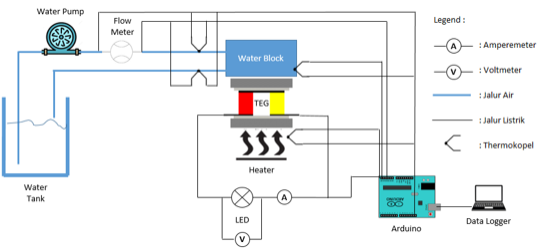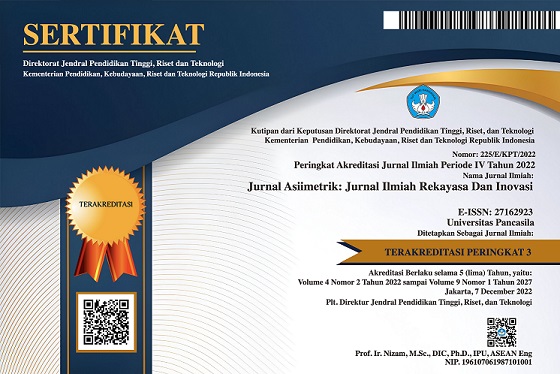Study Characteristic Thermal Electric Generator (TEG) Type SP1848 27145 SA
DOI:
https://doi.org/10.35814/asiimetrik.v6i1.5561Keywords:
thermal energy, TEG, seebeck effect, flow rate, correlationAbstract
The TEG component, which operates on the Seebeck principle like a thermocouple, is widely used in the market, with TEG SP1848 27145 SA being one of the most common types. However, experiments must be conducted to determine its Seebeck coefficient, voltage, and power output when used with different heat and cold sources. This research aims to observe how the Seebeck coefficient, voltage, and power output of TEG SP1848 27145 SA change with variations in system temperature. To experiment, TEG SP1848 27145 SA is tested with a heater, and water flow rates are varied for cooling. Furthermore, the correlation between output voltage and ΔT has been determined through statistical analysis. The experiment results showed that the voltage output ranged from 0.54–1.03 V at a heater temperature of 86°C and an ΔT system value of 70.5-75°C. The Seebeck value was between 1,551.7-2,998.5 µV, and the power output was 43.5-67.7 mW. Additionally, the statistical analysis found a significant correlation between the temperature variable and output voltage variable, with an adjusted r square value of 89.2% for zero water flow rate and increasing to 95.8% for maximum water flow rate.
Downloads
References
Agresti, A., Franklin, C. and Klingenberg, B. (2016) Statistics: The Art and Science of Learning from Data. 4th edition. Pearson. [Print].
Atmoko, N.T., Jamaldi, A. and Riyadi, T.W.B. (2022) ‘An Experimental Study of the TEG Performance using Cooling Systems of Waterblock and Heatsink-Fan’, Automotive Experiences, 5(3), pp. 261–267.
Banzi, M. and Shiloh, M. (2015) Getting Started with Arduino: The Open Source Electronics Prototyping Platform. 3rd edition. Sebastopol, CA: Make Community, LLC. [Print].
Halkos, G.E. and Gkampoura, E.-C. (2020) ‘Reviewing Usage, Potentials, and Limitations of Renewable Energy Sources’, Energies, 13(11), p. 2906.
Haripuddin, H., Irfan, M. and Suhardi, I. (2023) ‘Analysis Of Thermoelectric Potential SP1848-27145 SA as A Power Plant With Utilizing The Heat Energy of Combustion’, Journal of Electrical Engineering and Informatics, 1(1), pp. 16–25.
Holman, J.P. (1990) Heat Transfer. 7th edn. New York: McGraw-Hill. [Print].
Hudaya, C. (2021a) ‘Rancang Bangun Sistem Pemanfaatan Panas Buang Pada Kompor Portabel Menggunakan Thermoelectric Generator’, Jurnal TAMBORA, 5(1), pp. 66–71.
Hudaya, C. (2021b) ‘Rancangan Termoelektrik Generator (TEG) Portabel Pada Knalpot Sepeda Motor Dengan Material Alumunium Sebagai Konduktor’, Jurnal TAMBORA, 5(1), pp. 60–65.
Jaziri, N. et al. (2020) ‘A comprehensive review of Thermoelectric Generators: Technologies and common applications’, Energy Reports, 6, pp. 264–287.
Nurdinawati, V. (2017) ‘Studi Termoelektrik Generator Tipe TEG SP1848 27145 SA’, Techne: Jurnal Ilmiah Elektroteknika, 6(1), pp. 1–8.
Olabi, A.G. et al. (2022) ‘Potential applications of thermoelectric generators (TEGs) in various waste heat recovery systems’, International Journal of Thermofluids, 16, p. 100249.
Pfeiffelmann, B., Benim, A.C. and Joos, F. (2021) ‘Water-Cooled Thermoelectric Generators for Improved Net Output Power: A Review’, Energies, 14, p. 8329.
Pramana, S. (2016) Dasar-dasar statitiska dengan software R: konsep dan aplikasi. Bogor: Penerbit In Media. [Print].
Puspa, S.D., Riyono, J. and Puspitasari, F. (2021) ‘Analisis Faktor-Faktor yang Mempengaruhi Pemahaman Konsep Matematis Mahasiswa dalam Pembelajaran Jarak Jauh Pada Masa Pandemi Covid-19’, Jurnal Cendekia : Jurnal Pendidikan Matematika, 5(1), pp. 302–320.
Qasim, M.A. et al. (2022) ‘Design and Implementation of a Thermoelectric Power Generation Panel Utilizing Waste Heat Based on Solar Energy’, International Journal of Renewable Energy Research, Vol.12, pp. 1234–1241.
Rizaty, M.A. and Bayu, D. (2023) Bauran Energi Indonesia Masih Didominasi Batu Bara pada 2022. Available at: https://dataindonesia.id/energi-sda/detail/bauran-energi-indonesia-masih-didominasi-batu-bara-pada-2022 (Accessed: 10 February 2023).
Rogelj, J. et al. (2021) ‘Net-zero emissions targets are vague: three ways to fix’, Nature, 591(7850), pp. 365–368.
Saputra, W. et al. (2019) ‘Analysis of Artificial Neural Network in Predicting the Fuel Consumption by Type of Power Plant’, Journal of Physics: Conference Series, 1255(1), p. 012069.
Walpole, R.E. et al. (2017) Probability and Statistics for Engineers and Scientists. Pearson. [Print].
Wijayanto, H.L. et al. (2022) ‘Pengaruh Variasi Daya Pompa pada System Pendinginan TEG terhadap Tegangan yang Dihasilkan TEG’, Jurnal Ilmiah Universitas Batanghari Jambi, 22(1), pp. 477–481.





























